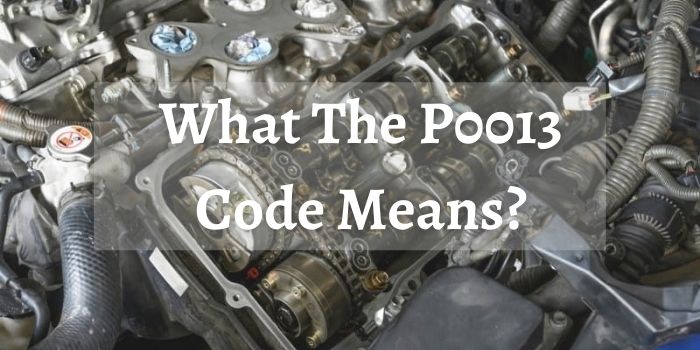Did you ever get the dreaded p0013 code on your car’s dashboard? You might not know what the code means, or what to do about it, but that doesn’t stop the light from flashing at you every time you start up your car. Today, we’re going to talk about the code p0013 – and what it might mean for your vehicle. So buckle up and get ready to learn all about it!
What The P0013 Code Means

The P0013 code is triggered when the engine control module (ECM) detects an open or short circuit in the bank 1 exhaust camshaft OCV. It can cause a variety of engine performance issues. In some cases, the engine may run rough or stall altogether. In other cases, the Check Engine Light may come on and the engine may hesitate when accelerating. If the P0013 code is set, it’s important to have the problem diagnosed and repaired as soon as possible to avoid further engine damage.
Cost of diagnosing the P0013 code
The cost of fixing this problem could vary depending on how serious it is and on what needs to be done. As it can happen for multiple reasons, a mechanic needs to diagnose the specific cause for this code. The cost for diagnosing the P0013 code is typically between $85 and $110. If the OBD2 scanner shows the trouble code p1101 chevy cruze as well, then the cost will be a bit more.
What Causes the P0013 code?
P0013 can be caused by a number of different things, including a worn timing chain, a defective camshaft position sensor, or a faulty actuator. Let’s get to know them in details.
Excessive Engine Oil Sludge
An engine needs clean oil to function properly. Sludge is a heavy, viscous type of oil residue that can build up over time, causing an engine to run less efficiently. The P0013 code indicates that there is excessive engine oil sludge present. This can be caused by several factors, including extended periods of driving without an oil change, using the wrong type of oil, or operating the vehicle in extreme temperatures.
Worn Timing Components
Timing components include the timing belt, timing chain, and timing gears. These parts are responsible for opening and closing the valves at the correct time. Over time, they can become stretched or damaged, causing the engine to run improperly. In some cases, this can lead to a P0013 code or P0345 in ford f150 5.4 as well. If you suspect that your timing components are worn, have them inspected by a professional as soon as possible.
Broken Camshaft Sensors
A broken Camshaft Sensor can cause your car to display error code P0013. This code can indicate that there is an issue with the Camshaft Position Sensor circuit. The Camshaft Position Sensor is responsible for telling the engine computer the position of the Camshaft so that it can synchronize the fuel injectors and ignition timing. Broken sensors are known to cause BMW fault code p0015 in cars as well.
Wiring Issue/Blown Fuse
The P0013 code can be caused if the electrical current flowing to the engine’s intake camshaft is not within the proper range. This can be caused by a wiring issue, a blown fuse, or a problem with the camshaft position sensor itself. If the P0013 code is set, the engine will likely experience reduced power and poor idle quality.
Symptoms of P0013 code

Decreased Engine Performance
If your ECU (engine control unit) can’t adjust the timings of your engine’s intake and exhaust valves, it will cause a decrease in engine performance. You might notice a decrease in acceleration or a decrease in overall engine power. This problem can be compounded if the p1326 fault code in Kia Optima appears as well.
The severity of the problem will determine how much engine performance is affected. In some cases, the engine may only run slightly slower than normal. In other cases, the engine may be barely able to run at all. If you’re experiencing decreased engine performance, it’s important to have your vehicle diagnosed by a professional as soon as possible.
Increased Fuel Consumption
One of the ways you can tell if there’s a problem with the system is by monitoring your fuel consumption. If you notice that your vehicle is using more fuel than usual, it could be a sign that the camshaft actuator is not functioning properly.
How To Diagnose The P0013 Code?
Step 1: Examine the electrical connector, valve, or wiring,
To diagnose this code, a mechanic will first analyze the electrical connector, wiring, or valve for any problem.
Step 2: Scan the codes
You need to then scan the computer codes and collect freeze frame data for finding out the exact time of the failure.
Step 3: Clear the codes
Next, clear the codes retest the car to find out if the P0013 returns.
Step 4: Inspect the OCV
After that, you should check the OCV for the right resistance. It should be between 6.9 and 7.9 ohms.
Step 5: Examine the shorted wiring
You should inspect if there’s shorted wiring from the ECM. But make sure the connections are removed.
Step 6: Conduct the manufacturer’s specific pinpoint tests
If the code comes back, then the Manufacturer’s Specific Pinpoint Tests will help you determine which system or component is causing the problem. These tests are specifically designed for each model, so it is important to have the right manual before you begin. Once you have the manual, follow the instructions carefully.
Common Mistakes To Avoid When Diagnosing The P0013 Code?
- Always do a visual examination to see if there’s any problem with wiring. Look for any signs of physical damage or corrosion.
- Check the engine oil level and condition. If the oil is low or dirty, it could be causing the P0013 code to be triggered.
- Use the manufacturer’s pinpoint test to help you narrow down the possible causes of the code.
- Many people replace the sensors without first testing them. This is often a waste of time and money, as the sensors may not be the cause of the P0013 code
How Serious Is The P0013 Code?
While the P0013 code is not always serious, it is important to get it checked out by a mechanic as soon as possible to avoid further damage. Below are some of the issues it can cause.
Engine may stall
The OCV regulates how much oil flows through the engine. If there is not enough oil flowing through the engine, it can cause the engine to run rough and stall.
Fuel consumption will be significantly increased
In addition, the engine’s fuel consumption may increase or the internal valve components may become carbon-fouled.
Can Damage the ECM
Driving the vehicle with the P0013 code for a long period of time may also harm the ECM.
How to Fix Code P0013
Here are the solutions you can employ.
Change the Oil and Filter
In most cases, the fix is as simple as an oil and filter change. This will usually clear the code and reset the system. If the code keeps coming back, then there may be a more serious problem that will require further diagnosis
Install new Worn Timing Components
If you have this code, replacing the worn timing components can be the solution. Failure to do so in time could result in a snapped timing belt, which would total your engine. Luckily, if you catch the problem early, it is a relatively easy fix. Simply replacing the worn timing components should be enough to eliminate the code P0013 and get your car running smoothly again.
Replace Camshaft Sensors
In order to fix code P0013, you may need to replace the camshaft position sensor. This part is responsible for monitoring the position of the camshaft and relaying that information to the engine control unit. If the sensor is faulty, it can cause the engine to run erratically or stall altogether.
Fortunately, camshaft sensors are relatively inexpensive and easy to replace. Simply remove the old sensor and install the new one in its place. Once the new sensor is in place, restart the engine and check for any codes. If there are no codes present, then the problem has been successfully resolved.
Try Troubleshooting Electrical Fault
An electrical fault could prevent power reaching to the camshaft position sensor or actuator. The first thing you should do is check the fuse to see if it’s still intact. If it is, then the problem is likely somewhere in the wiring harness.
Troubleshooting this kind of issue can be tricky, especially if you don’t know how to do it. It can take a long time to find the fault if you don’t know what you’re doing.
FAQs
1. Can low oil cause P0013?
Ans: Yes, a low oil level is able to trigger P0013.
Variable Valve Timing or VVT system in your car is responsible for regulating the timing of your engine’s valves, and it relies on oil pressure to function properly. If your car’s oil level is too low, it can cause the VVT system to fail, triggering the P0013 code.
2. How do you fix a code P0013 on a Chevy Equinox
Ans: By following the procedure we detailed in the section based on fix.
3. Can I drive my car with a P0013 code?
Ans: While you can still drive your car with this code, it is not advisable to do so. Driving with a P0013 code can cause further damage to your engine and may even lead to a total engine failure. If you must drive with a P0013 code, be sure to drive slowly and avoid accelerating too quickly.
Conclusion
P0013 code is usually an indication that there’s something wrong with the engine. If you see it, you should take their car to a mechanic to get it fixed as soon as possible. Since the code doesn’t give any specific information about what might be wrong, the mechanic will have to do some tests to find out where the problem is.
Related Posts:
P1131 Ford Code | Causes & Solutions
P0012 BMW: Intake Camshaft Position Timing- Over-Retarded (Bank 1)
P0300 BMW: Meaning, Causes, Symptoms, & Fixes